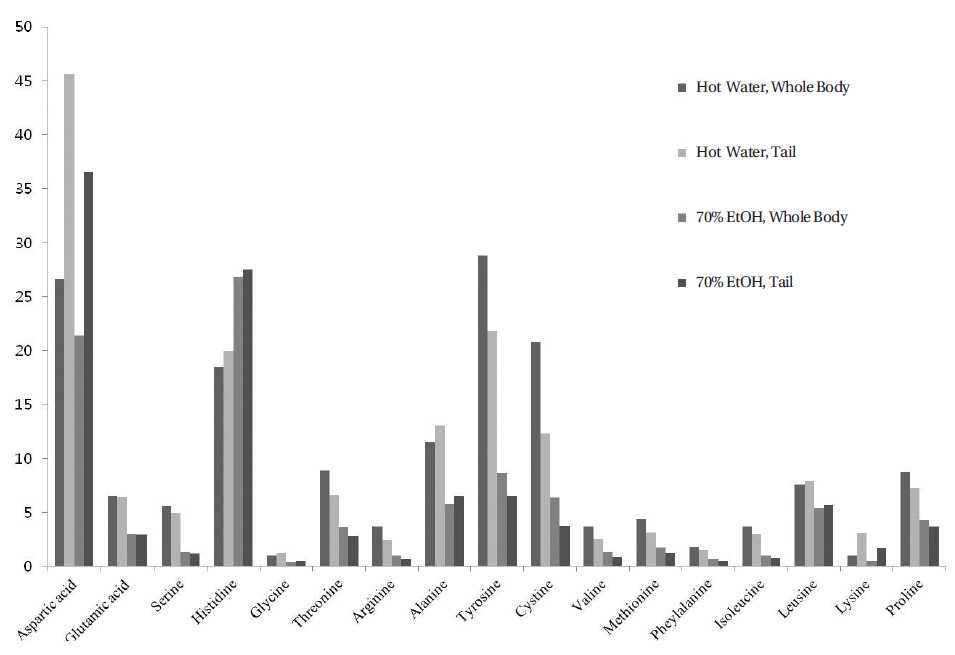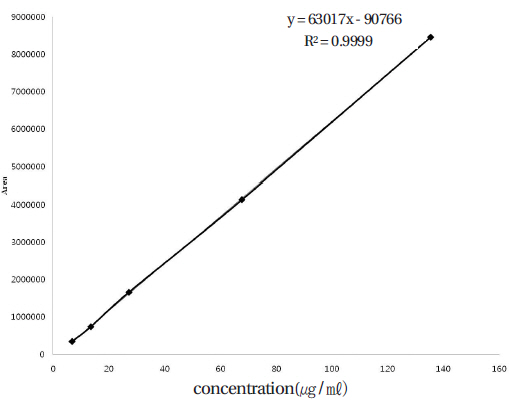



Choi et al. reported that methanol (MeOH) extraction had an inhibitory effect on nitric-oxide and cytokine production in lipopolysaccharide-activated Raw 264.7 cells [8]. Cho et al. reported that the anti-arthritic effects of
In the past, the scorpion’s tail was thought to be more potent. However, in recent years, the entire scorpion has typically been used even though no differences between the effects of the entire scorpion and its tail have been reported [1]. However, the text
Therefore, the present study analyzed the differences in the amino acids in the tail and the full body of a scorpion. The differences were obtained by comparing the amino acids 70% ethanol and hot water extracts.
The carefully-selected scorpion used in this experiment was purchased from
3.1.1. Hot water extracts
The scorpion (dry weight: 300 g) was loaded at the bottom of a reactor, and water (3 L) was added to the reactor for injection into the impeller, the upper part of the reactor, the bottom of reactor and the cooling pipe (reflux). The substance was boiled at 105℃ for 3 h. After the extract had been filtered by using 3-㎛ filter paper (
3.1.2. Ethanol (70%) extracts
The scorpion (dry weight: 300 g) was loaded at the bottom of a reactor, and 70% ethanol (3 L) was added to the reactor for injection into the impeller, the upper part of the reactor, the bottom of reactor and the cooling pipe (reflux). The substance was boiled at 105°C for 3 h. After the extract had been filtered using 3-㎛ filter paper (
3.1.3. Extracts of the scorpion’s tail
The scorpion’s tail (dry weight: 300 g) was treated in the same way for both the 70% ethanol extract and the water extract.
3.2. Sample preparation for the HPLC analysis of amino
acids
If an amino-acid analysis is to be conducted using ordinary HPLC, the sample needs derivatization. After borate buffer had been added to each standardized sample and the scorpion extract had been stirred well, OPA and FMOC were added and stirred. The standardized samples, which had been derivatized as above, were then diluted in a stepwise manner into five concentrations, which were then spun for 15 s and used after having been filtered through a 0.45-㎛ membrane syringe filter. Mobile phase A (with phosphoric acid) was used as the dilution solution.
The conditions for each HPLC analysis of the amino acids were based on those in Refs. 12 and 13. The column temperature and the UV wavelength were 40℃ and 262 nm, respectively. Mobile phase A consisted of pure water with 10-mM Na2HPO4, 10-mM Na2B4O7, and 5-mM NaN3 and was calibrated to pH 8.2. Mobile phase B consisted of acetonitrile, methanol, and water mixed at a ratio of 45:45:10. The flow rate was 1.5 ㎖/min. The conditions of the analysis are shown in (Table 1)
3.4.1. Linearity
The peak area ratio was measured using the standardized amino-acid samples that had been weighed into five different concentrations. The calibration curve was created using the regression equation obtained in the form y = ax + b (with x being the peak area and y the sample concentration). The linearity of the created calibration curve was determined using the value of
3.4.2. Precision
In order to observe any subtle intra- and inter-day changes, we divided the standardized samples into five various concentrations, and we examined them five times a day for three days. The precision was evaluated using the relative standard deviation from the measured values. The sum of the area values of 17 types of amino acids was used in the verification process.
3.4.3. Accuracy
The results obtained from injecting the standardized samples at three various concentrations three times were substituted into the calibration curve, and the resultant value was compared with the true value to assess the accuracy: 90%-100%.
Dried scorpion, 300 g, was extracted by means of hydrothermal extraction and then immersed in ethanol at a concentration from 75% to 95%. This was then freezedried into 30.0 g of powder. The closing rates are as shown in (Table 2) In addition, 300 g of dried scorpion was extracted under 70% ethanol three times and then immersed in ethanol at a concentration from 75% to 95%. This was then freeze-dried into 30.0 g of powder. The closing rates are as shown in (Table 2) The extracts from the scorpion’s tail were obtained in the same way as the hot water and the 70% ethanol extracts. Dried scorpion’s tail, 300 g, was extracted in the same way as the hot water extracts, was then immersed in ethanol at a concentration from 75% to 95%, and was freeze-dried into 28.1 g of powder. The closing rates are shown in (Table 2)
[Table. 1] Operating conditions of HPLC for amino acid analysis
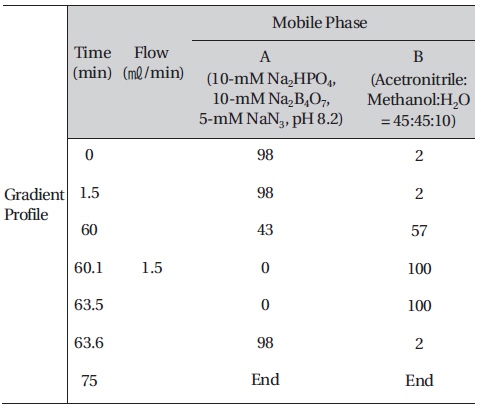
Operating conditions of HPLC for amino acid analysis
4.2.1. Amino acid analyses of the extracts obtained from the scorpion’s tail and its entire body by using hydrothermal extraction
The results of the HPLC analyses of the contents of amino acids in the extracts derived from the scorpion’s tail and its entire body by using hydrothermal extraction are as shown in (Table 3) Seventeen kinds of amino acids in both extracts were identified, and the total amino acid contents in the extracts from the tail and the entire body were 162.8392 ㎎/g and 163.0755 ㎎/g, respectively. This study revealed that the 17 types of amino acids contained aspartic acid, histidine, alanine, tyrosine and cystine in large amounts: 26.6787, 18.4964, 11.4944, 28.8083 and 20.7936 ㎎/g, respectively, in the extract from the scorpion’s entire body, and 45.632, 19.9854, 13.0293, 21.8338 and 12.311 ㎎/g in the extract from the scorpion’s tail. The contents of the other amino acids are shown in (Fig 1) Most amino acids were found in similar amounts in the extracts from the scorpion’s entire body and the extracts from its tail, but the extract from the scorpion’s tail contained 71% more aspartic acid than the extract from the entire body.
4.2.2. Amino acid analyses of the extracts obtained from the scorpion’s tail and its entire body by using the 70% ethanol extraction method
The results of the HPLC analyses of the contents of amino acids in the extracts derived from the scorpion’s tail and its entire body by using 70% ethanol extraction are as shown in (Table 3) Seventeen kinds of amino acids in both extracts were identified, and the total amino acid contents in the extracts from the tail and the entire body were 93.4242 ㎎/g and 103.4810 ㎎/g, respectively. This study revealed that the 17 types of amino acids contained aspartic acid, histidine, alanine, tyrosine and leusine in large amounts, with the contents being 21.4016, 26.7793, 5.7639, 8.7088 and 5.4464 ㎎/g, respectively, in the wholebody extracts, and 36.5224, 27.4986, 6.5252, 6.5438 and 5.7001 ㎎/g in the tail extracts. The contents of the other amino acids are shown in (Fig 1) Most amino acids were found in similar amounts in the extracts from the scorpion’s entire body and the extracts from its tail, but the extracts from the scorpion's tail contained 71% more aspartic acid than the extracts from the entire body. A comparison between the two extraction methods revealed that, in general, more amino acids, with the only exception being histidine for which a larger amount was extracted through the 70% ethanol extraction method, were extracted through the hydrothermal extraction method.
[Table. 2] Yield of freeze-dried powder according to the extraction
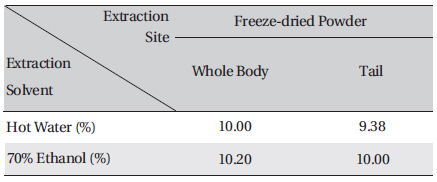
Yield of freeze-dried powder according to the extraction
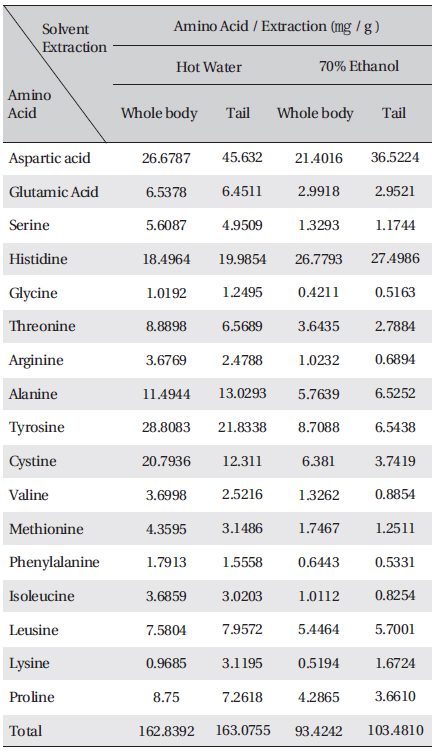
Analysis of amino-acid compositions of the hot water and the 70% ethanol extracts from a scorpion
Standardized solutions were produced for each amino acid in concentrations of 6.774, 13.548, 27.096, 67.74 and 135.48 ㎍/㎖and were analyzed using the established procedures for HPLC amino-acid analysis. As shown in (Fig 2), the calibration curve was plotted with a linearity (
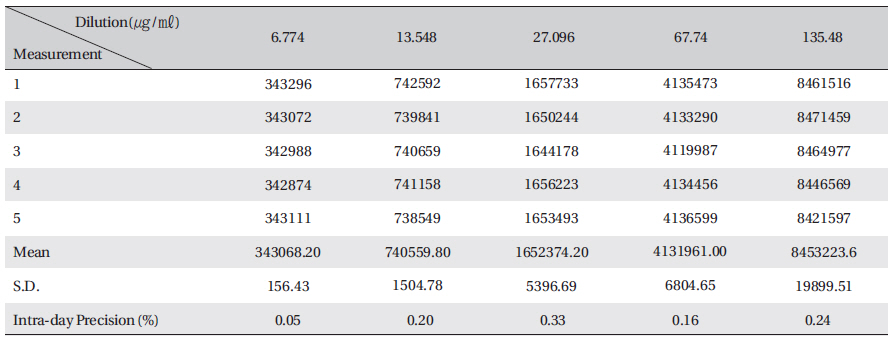
Peak areas of the sums of amino acids analyzed in five different concentrations for determining the intra-day precision

Peak areas of the sums of amino acids analyzed in five different concentrations for determining the inter-day precision
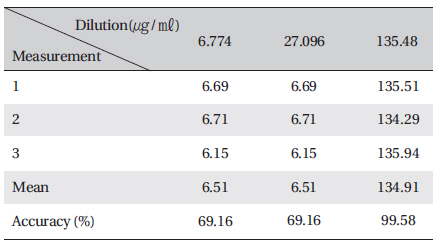
Calculated concentrations of the sums of amino acids analyzed in three different concentrations for accuracy
The Pharmacopoeia of Taiwan suggests that the scorpion’s body and its tail be separated when it is used as medicine.
Amino acids can take various forms, depending on their chemical structure. Mainly, amino acids are present as components of proteins or as free amino acids. Small amounts of amino acids are present as peptides or as complex proteins combined with sugars or lipids [14].
A total of 17 types of amino acids were analyzed in the extracts from the scorpion’s entire body and from its tail. Amino acids such as aspartic acid, histidine, alanine, tyrosine, cystine, and leusine were identified in large amounts while glycine, phenylalanine, and lysine were identified in small amounts. Aspartic acid prevents body fatigue, protects the immune system by producing immunoglobulin and antibodies, and removes excess ammonia and toxins from the bloodstream, thereby preventing damage to the liver and the central nervous system (CNS) [15]. Valine contributes to muscle recovery after exercise, vitality of the spirit, the growth of new tissues, and the healing of wounds [16]. Arginine stimulates the secretion of growth hormones, regulates blood pressure, inhibits the proliferation of cancer cells, and enhances the immune system. In particular, when fats and fatty oils are added, arginine becomes softer, and emulsification is increased, which leads to effective antioxidant response [17]. Phenylalanine, which produces norepinephrine, actives thinking, improves the memory and learning ability, and decreases the appetite [18]. Isoleucine acts to maintain blood sugar and energy [19]. As previously mentioned, scorpions contain a large variety of amino acids with various medical benefits.
In this study, the extraction yield-rate of the 70% ethanol extraction method was higher than that of the hydrothermal extraction method, but the amino acid content was higher in the hydrothermal extracts than in the 70% ethanol extracts. The amount of histidine extracted through the 70% ethanol method was the only exception and was detected to be 41.0% higher. This study did not show any significant differences in the contents of the amino acids between the scorpion’s tail and its body, but the content amount of aspartic acid was detected to be approximately 71% higher in the tail section. Although scorpions contain many ingredients other than amino acids [20], the results of the analysis of the 17 amino acids revealed that little difference in the contents existed between the scorpion’s tail and its body and that the hydrothermal extraction method was more effective in extracting large amounts of amino acids than the 70% ethanol extraction method.
Often buthotoxin, a component of scorpion’s venom, is extensively researched, leaving amino acids, fatty acids, etc. unexplored. If research on components of the scorpion other than buthotoxin is carried out consistently, not only could it be used in supporting the previously known medical efficacy of the scorpion, such as antiepileptic efficacy, anticancer activity, anti-thrombotic action and analgesic effect, but also it might uncover many more efficacies that have yet to be discovered. As a direct means of physical administration, caution should be taken to maintain a high purity of ingredients when applying pharmacopuncture, and given the above points, use of only the tail of the scorpion would be desirable.



